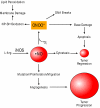Heat-shock proteins in infection-mediated inflammation-induced tumorigenesis
- PMID: 19183457
- PMCID: PMC2644312
- DOI: 10.1186/1756-8722-2-5
Heat-shock proteins in infection-mediated inflammation-induced tumorigenesis
Abstract
Inflammation is a necessary albeit insufficient component of tumorigenesis in some cancers. Infectious agents directly implicated in tumorigenesis have been shown to induce inflammation. This process involves both the innate and adaptive components of the immune system which contribute to tumor angiogenesis, tumor tolerance and metastatic properties of neoplasms. Recently, heat-shock proteins have been identified as mediators of this inflammatory process and thus may provide a link between infection-mediated inflammation and subsequent cancer development. In this review, the role of heat-shock proteins in infection-induced inflammation and carcinogenesis will be discussed.
Figures



Similar articles
-
Oxidative stress, inflammation, and cancer: how are they linked?Free Radic Biol Med. 2010 Dec 1;49(11):1603-16. doi: 10.1016/j.freeradbiomed.2010.09.006. Epub 2010 Sep 16. Free Radic Biol Med. 2010. PMID: 20840865 Free PMC article. Review.
-
Heat Shock Proteins Are Essential Components in Transformation and Tumor Progression: Cancer Cell Intrinsic Pathways and Beyond.Int J Mol Sci. 2019 Sep 11;20(18):4507. doi: 10.3390/ijms20184507. Int J Mol Sci. 2019. PMID: 31514477 Free PMC article. Review.
-
Molecular mechanisms underlying chronic inflammation-associated cancers.Cancer Lett. 2014 Apr 10;345(2):164-73. doi: 10.1016/j.canlet.2013.08.014. Epub 2013 Aug 26. Cancer Lett. 2014. PMID: 23988267 Free PMC article. Review.
-
Inflammation-induced cancer: crosstalk between tumours, immune cells and microorganisms.Nat Rev Cancer. 2013 Nov;13(11):759-71. doi: 10.1038/nrc3611. Nat Rev Cancer. 2013. PMID: 24154716 Review.
-
Metabolic reprogramming of stromal fibroblasts through p62-mTORC1 signaling promotes inflammation and tumorigenesis.Cancer Cell. 2014 Jul 14;26(1):121-135. doi: 10.1016/j.ccr.2014.05.004. Epub 2014 Jul 4. Cancer Cell. 2014. PMID: 25002027 Free PMC article.
Cited by
-
Components of rhizome extract of Cnidium officinale Makino and their in vitro biological effects.Molecules. 2011 Oct 21;16(10):8833-47. doi: 10.3390/molecules16108833. Molecules. 2011. PMID: 22019572 Free PMC article.
-
Azacytidine induces necrosis of multiple myeloma cells through oxidative stress.Proteome Sci. 2013 Jun 13;11(1):24. doi: 10.1186/1477-5956-11-24. Proteome Sci. 2013. PMID: 23764212 Free PMC article.
-
Blockade of PI3K/AKT pathway enhances sensitivity of Raji cells to chemotherapy through down-regulation of HSP70.Cancer Cell Int. 2013 May 24;13(1):48. doi: 10.1186/1475-2867-13-48. Cancer Cell Int. 2013. PMID: 23706027 Free PMC article.
-
The Osteoprotective Effects Of Kaempferol: The Evidence From In Vivo And In Vitro Studies.Drug Des Devel Ther. 2019 Oct 7;13:3497-3514. doi: 10.2147/DDDT.S227738. eCollection 2019. Drug Des Devel Ther. 2019. PMID: 31631974 Free PMC article. Review.
-
Muscadine grape skin extract inhibits prostate cancer cells by inducing cell-cycle arrest, and decreasing migration through heat shock protein 40.Heliyon. 2019 Jan 16;5(1):e01128. doi: 10.1016/j.heliyon.2019.e01128. eCollection 2019 Jan. Heliyon. 2019. PMID: 30705983 Free PMC article.
References
-
- Pisani P, Parkin DM, Munoz N, Ferlay J. Cancer and infection: estimates of the attributable fraction in 1990. Cancer Epidemiol Biomarkers Prev. 1997;6:387–400. - PubMed
Publication types
MeSH terms
Substances
LinkOut - more resources
Full Text Sources
Other Literature Sources

